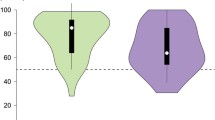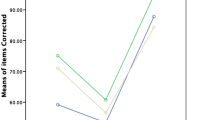Abstract
Several theorists have suggested that deficits in visual discrimination play an etiological role in the development of reading deficits in children who are diagnosed as learning-disabled. Supporting this theory, a number of studies have shown that disabled readers make more errors on visual discrimination tasks than do good readers. The present study, however, suggests that those findings may have been due to a sex-difference artifact. Thirty-six 8- and 9-year-old good readers and reading-disabled children of both sexes responded to 40 matching items under untimed conditions. Males made more errors than females, but overall, reading-disabled children made no more errors than good readers. These findings, along with a reanalysis of previous studies, suggest that because reading disabilities are more common in males, evidence construed as supporting a visual discrimination hypothesis may have been an artifact of a sex difference in studies in which sex was not controlled.
Similar content being viewed by others
References
Bonsall, C., & Dornbush, R. L. Visual perception and reading ability.Journal of Educational Psychology, 1969,60, 294–299.
Fisher, D. F., & Frankfurter, A. Normal and disabled readers can locate and identify letters: Where's the perceptual deficit?Journal of Reading Behavior, 1977,9, 31–43.
Frostig, M., & Home, D.The Frostig program for the development of visual perception. Chicago: Follett Educational Corporation, 1964.
Getman, G. N., & Kane, E. R.The physiology of readiness: An action program for the development of perception for children. Minneapolis: Programs to Accelerate School Success. 1964.
Hallahan, D. P., & Kauffman, J. M.Introduction to learning disabilities. Engelwood Cliffs, New Jersey: Prentice-Hall, 1976.
Hammill, D. Training visual perception processes.Journal of Learning Disabilities, 1972,5, 552–559.
Keith, R. M. Do disorders of perception occur?Developmental Medicine and Child Neurology, 1977,19, 821–825.
Lahey, B. B., & Lefton, L. A. Discrimination of letter combinations in good and poor readers.Journal of Special Education, 1976,10, 205–210.
Lahey, B. B., & McNees, M. P. Letter discrimination errors in kindergarten through third grade: Assessment and operant training.Journal of Special Education, 1975,9, 191–199.
Larsen, S. C., & Hammill, D. D. The relationship of selected visual perceptual abilities to school learning.Journal of Special Education, 1975,9, 281–291.
Lefton, L. A., Lahey, B. B., & Stagg, D. I. Eye movements in reading disabled and normal children: A study of systems and strategies.Journal of Learning Disabilities, 1978,11, 549–558.
Linder, R., & Fillmer, H. T. Auditory and visual performance of slow readers.Reading Teacher, 1970,24, 17–22.
Lyle, J. G. Reading retardation and reversal tendency: A factorial study.Child Development, 1969,40, 833–843.
Lyle, J. G., & Goyen, J. Visual recognition, development lag and strephosymbolia in reading retardation.Journal of Abnormal Psychology, 1968,73, 25–29.
Lyle, J. G., & Goyen, J. Effect of speed of exposure and difficulty of discrimination on visual recognition of retarded readers.Journal of Abnormal Psychology, 1975,84, 673–676.
Orton, S.Reading, writing and speech problems in children. New York: W. W. Norton, 1937.
Ross, A. O.Psychological aspects of learning disabilities and lerning disorders. New York: McGraw-Hill, 1976.
Rutter, M.Helping troubled children. London: Plenum, 1976.
Shea, C. A. Visual discrimination of words and reading readiness,Reading Teacher, 1968,21, 361–367.
Steinheiser, R., & Guthrie, J. T. Perceptual and linguistic processing of letters and words by normal and disabled readers.Journal of Reading Behavior, 1977,9, 217–225.
Vellutino, F. R. Alternative conceptualizations of dyslexia: Evidence in support of a verbal-deficit hypothesis.Harvard Educational Review, 1977,47, 334–354.
Vellutino, F. R., Smith, H., Steger, J. A., & Kama, M. Reading disability: Age differences and the perceptual deficit hypothesis.Child Development, 1975,46, 487–493.
Vellutino, F. R., Steger, J. A., & Kandel, G. Reading disability: An investigation of the perceptual deficit hypothesis.Cortex, 1972,8, 106–118.
Wechsler, D., & Hagin, R. A. The problem of axial rotation in reading disability.Perceptual and Motor Skills, 196419, 319–326.
Author information
Authors and Affiliations
Rights and permissions
About this article
Cite this article
Lahey, B.B., Lefton, L.A., Sperduto, G.R. et al. Visual discrimination deficits of reading-disabled children: Sex artifact?. J Abnorm Child Psychol 8, 111–115 (1980). https://doi.org/10.1007/BF00918165
Issue Date:
DOI: https://doi.org/10.1007/BF00918165




